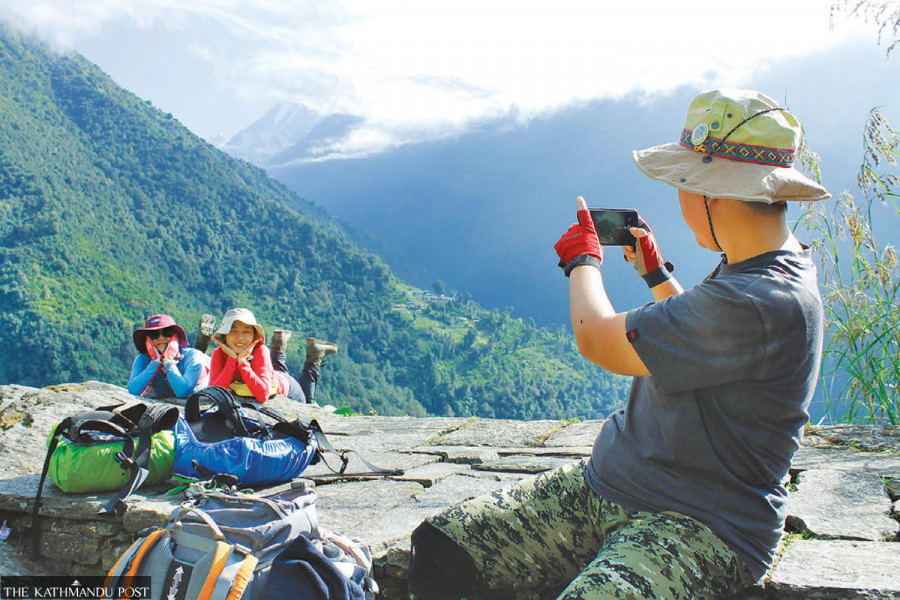Columns
Welcoming Chinese tourists
China’s support to Nepal as a tourist destination is vital to recover from economic losses.
Anurag Acharya & Aslesh Shrestha
“True beauty always touches the deep heart. Beautiful Nepal with history, diversity, and nature deserves a visit. Wish #VisitNepal2020 successful!” then Chinese ambassador to Nepal, Hou Yanqi, had tweeted on New Year's Eve (2019) to promote the Visit Nepal 2020 tourism campaign. Chinese President Xi Jinping had given his support for the tourism year during his visit in October 2019. The Nepal Tourism Board had also gone all out with a promotional campaign in China, appointing Chinese actress Xu Qing as Goodwill Ambassador in a bid to attract Chinese tourists. Her selfies with the picturesque Annapurna mountain in the background had created quite a buzz on social media.
Beijing had been promoting Nepal as a tourist destination since 2016, leading to a steady rise in Chinese tourists in the years leading to 2020. Then Covid-19 struck, and Nepal’s tourism went through its worst period, with thousands of people losing their businesses and jobs. The years 2020 and 2021 were disastrous for tourism in Nepal, like in many countries around the world.
China’s outbound tourists
In 2002, Beijing included Nepal in the list of approved destinations for its large number of outbound tourists. In the years since, Chinese restaurants began popping up in Thamel, Kathmandu and Lakeside, Pokhara. Language centres opened to provide Mandarin classes to trekking guides, restaurant waiters and salespeople.
Tourist arrivals to Nepal swelled to almost 1.2 million by 2019, with Chinese tourists making up 14.2 percent of the total. Despite the surge, insiders say that lack of quality tourism infrastructure, expensive air tickets and language problems could dissuade them from visiting Nepal.
To address these concerns, Nepal can promote direct flights by budget carriers to newly opened Bhairahawa and Pokhara international airports, thereby cutting travel costs and improving connectivity with Chinese cities.
China’s strict Covid-19 protocol has seriously affected Chinese outbound tourism. But Beijing has relaxed the restrictions, and some cities have resumed direct flights to Kathmandu. The number of Chinese travellers to Nepal remains modest compared to pre-Covid years, but if more cities permit international flights to Kathmandu, Pokhara and Bhairahawa, arrivals could rise.
More Chinese tourists means more Chinese currency to pay for imports from China. Given Nepal’s meagre exports to China, one way to draw in renminbi reserves is to boost tourism. Another factor that must be considered is the potential to increase foreign direct investment (FDI) from China. According to the Department of Industry, the tourism sector received investments of more than Rs25 billion in the past five years, with China accounting for the largest share of FDI commitments.
However, there are also some challenges that we need to think about. It has been reported that Chinese businesses and nationals have been using payment gateways like AliPay and WeChat Pay to make online payments. This system bypasses the Nepali economy, allowing Chinese tourists to buy goods and services from Chinese businesses in Nepal without having to conduct the transaction in local currency. The inability of government authorities to bring these transactions within Nepal’s formal economic channels could lead to continued losses in tax revenue.
In this regard, the recent policy change reducing the minimum FDI requirement from Rs50 million to Rs20 million could incentivise prospective Chinese entrepreneurs. But, if unregulated, it could also encourage shadow businesses. Besides, the government must also be aware of the continuous increase in the number of Chinese-owned hotels, restaurants and travel agencies, and the ease with which they can dominate the local market in catering to Chinese tourists, potentially pushing local businesses to the brink of closure. No economic gain can be sustained in the absence of harmonious social relations.
Tourism diplomacy
Globally, China’s large outbound tourism is quickly becoming a soft power for Beijing. Its smart tourism diplomacy has also allowed it to diversify its FDI markets, including through bustling Chinatowns across various countries. Like Nepal, most tourist destinations around the world are waiting for an influx of Chinese tourists. However, these countries should also be wary of China’s tendency to use its large outbound tourism as soft power, especially to express its displeasure with governments in the host country. China has, in the past, imposed undeclared sanctions against South Korea, Japan and Vietnam, discouraging its travel operators from selling tour packages to these nations. Nepal, too, has faced unexplained restrictions on imports and exports, which were lifted as soon as the new communist party government came to power. Such manoeuvres not only lead to significant losses in revenues for the host countries, but also reduce confidence in China as a reliable tourism source country.
As Nepal looks to recover from economic losses incurred during the pandemic, China’s support to Nepal as a tourist destination must be welcomed, as it will certainly boost the domestic tourism sector and its share in the GDP. But our policymakers must also be aware of the risks of putting all eggs in one basket. Nepal hosts many Tibetan refugees, has an open border with India on three sides and is, therefore, in a geopolitically sensitive spot. However large gains it may bring, the over-dependence of Nepal’s tourism sector on Chinese tourists could eventually weaken our ability to exercise an independent foreign policy and potentially create an economic weak spot. Our over-dependence on the Indian market for both imports and exports has already crippled our bargaining power with one neighbour. We must learn from that mistake.




 10.12°C Kathmandu
10.12°C Kathmandu
















